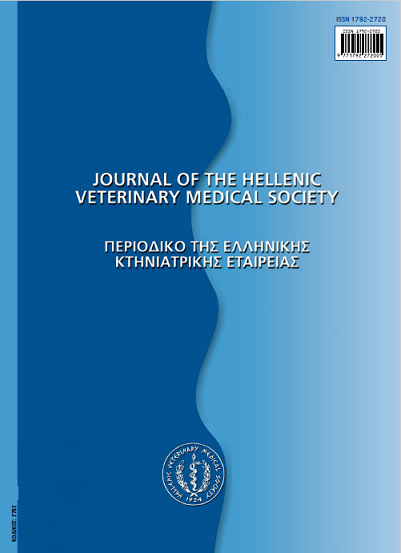Έλεγχος διοξινών και παρόμοιων τοξικών ρύπων σε τρόφιμα ζωικής προέλευσης στην Ελλάδα

Περίληψη
Οι πολυχλωριωμένες διβενζο-παρα-διοξινες (PCDDs) τα πολυχλωριωμένα διβενζοφουράνια (PDCFs) και τα«παρόμοια με διοξίνες» πολυχλωριωμένα διφαινΰλια (PCBs) ανήκουν στους ανθεκτικούς οργανικούς ρύπους. Τα PCDDs και PCDFs δεν έχουν ποτέ παραχθεί σκοπίμως, αλλά παράγονται κατά την ατελή καύση οργανικών υλικών παρουσία χλωρίου.Τα PCBs, αντίθετα, έχουν βρει διάφορες βιομηχανικές εφαρμογές μέχρις ότου απαγορεύτηκε η παραγωγή τους τη δεκαετία του '70. Οι ενώσεις αυτές αλληλεπιδρούν με τον υποδοχέα αρυλο υδρογονανθράκων (AH) προκαλώντας σοβαρή τοξικήδράση στον ανθρώπινο οργανισμό μετά από χρόνια, που περιλαμβάνει επίδραση στην ανάπτυξη και το ανοσοποιητικό σύστημα,καρκινογένεση και χλωρακμή. Πάνω από το 90% της ημερήσιας ανθρώπινης πρόσληψης οφείλεται στη διατροφή και, μάλιστα,λόγω της λιποφιλικότητας των ενώσεων αυτών, οι τροφές που είναι πιο επιβαρυμενες στις ενώσεις αυτές είναι τα προϊόνταπου περιέχουν λίπος, κυρίως τα λιπαρά τρόφιμα ζωικής προέλευσης (γαλακτοκομικά προϊόντα, κρέας, αβγά) και τα λιπαρά ψάρια. Η Ευρωπαϊκή Ένωση (ΕΕ) έχει θεσπίσει μέγιστα επιτρεπτά όρια για τα PCDD/Fs και τα PCBs στα τρόφιμα, μεσκοπό τον έλεγχο την επιβάρυνσης τους. Το Εργαστήριο Φασματομετρίας Μάζας κι Ανάλυσης Διοξινών «ΕΦΑΜΑΔ» του ΕΚΕΚΕ «Δημόκριτος» λειτουργεί από το 2002, διεξάγοντας μεταξύ άλλων προσδιορισμό διοξινών σε τρόφιμα, ζωοτροφές,βιολογικά και περιβαλλοντικά δείγματα εφαρμόζοντας διεθνή πρωτοκόλλα (EPA 1613, EPA 1668), με κατάλληλη επεξεργασίατου δείγματος και μέτρηση σε φασματογράφο μάζας υψηλής διακριτικής ικανότητας, όπως ορίζονται στον κανονισμό1883/2006/ΕΚ. Το Εργαστήριο είναι διαπιστευμένο κατά ISO/IEC 17025 από το ΕΣΥΔ (Αρ. Πιστ. 321) και είναι το Εθνικό Εργαστήριο Αναφοράς για την Ελλάδα και την Κύπρο. Στην παρούσα ανασκόπηση παρουσιάζονται συνολικά οι δραστηριότητεςτου ΕΦΑΜΑΔ από την αρχή της λειτουργίας του, όσον αφορά στην παρακολούθηση των επίπεδων διοξινών και παρόμοιωνμε τις διοξίνες ενώσεων σε τρόφιμα ζωικής προέλευσης από την ελληνική αγορά. Το Εργαστήριο ανταποκρίνεται στιςαπαιτήσεις των κρατικών φορέων έλεγχου τροφίμων σε τακτική βάση, μέσω της ανάλυσης μεγάλου αριθμού δειγμάτωντροφίμων που λαμβάνονται με τυχαία δειγματοληψία, από τρόφιμα που διακινούνται και καταναλώνονται στην Ελλάδα. Τα αποτελέσματα των αναλύσεων αυτών δείχνουν ότι τα τρόφιμα που κυκλοφορούν στην ελληνική αγορά είναι αρκετά κάτω απότα μέγιστα αποδεκτά όρια που έχει ορίσει η ΕΕ με τον κανονισμό 1881/2006/ΕΚ και γενικά κάτω από αυτά που αναφέρονταιγια άλλες ευρωπαϊκές και μεσογειακές χώρες. Επίσης, το ΕΦΑΜΑΔ έχει εκπονήσει μελέτες σε περιοχές όπου υπάρχουνυπόνοιες για επιβάρυνση τροφίμων από διοξίνες και παρόμοιες με διοξίνες ενώσεις, π.χ. λόγω της έκθεσης σε μολυσμένητέφρα μετά από πυρκαγιές, κοντά σε χωματερές ή από βιομηχανική ρύπανση. Μερικά από τα δείγματα που αναλύθηκαν στις μελέτες αυτές εμφάνισαν ασυνήθιστα υψηλά επίπεδα επιβάρυνσης, ακόμα και πάνω από τα όρια που έχει θεσπίσει η ΕΕ. Στιςπεριπτώσεις αυτές, η δραστηριότητα του ΕΦΑΜΑΔ ήταν σημαντική για την προστασία της δημόσιας υγείας. Συγκεκριμένα,λήφθηκαν κατάλληλα μέτρα ώστε τα αντίστοιχα τρόφιμα να απομακρυνθούν από την κατανάλωση και να επανέλθουν οι συγκεντρώσεις διοξινών στα παραγόμενα τρόφιμα στα φυσιολογικά τους επίπεδα
Λεπτομέρειες άρθρου
- Πώς να δημιουργήσετε Αναφορές
-
VASSILIADOU (Ε. ΒΑΣΙΛΕΙΑΔΟΥ) I., COSTOPOULOU (Δ. ΚΩΣΤΟΠΟΥΛΟΥ) D., & LEONTIADIS (Λ. ΛΕΟΝΤΙΑΔΗΣ) L. (2017). Έλεγχος διοξινών και παρόμοιων τοξικών ρύπων σε τρόφιμα ζωικής προέλευσης στην Ελλάδα. Περιοδικό της Ελληνικής Κτηνιατρικής Εταιρείας, 62(2), 141–149. https://doi.org/10.12681/jhvms.14843
- Τεύχος
- Τόμ. 62 Αρ. 2 (2011)
- Ενότητα
- Review Articles
Οι συγγραφείς των άρθρων που δημοσιεύονται στο περιοδικό διατηρούν τα δικαιώματα πνευματικής ιδιοκτησίας επί των άρθρων τους, δίνοντας στο περιοδικό το δικαίωμα της πρώτης δημοσίευσης.
Άρθρα που δημοσιεύονται στο περιοδικό διατίθενται με άδεια Creative Commons 4.0 Non Commercial και σύμφωνα με την άδεια μπορούν να χρησιμοποιούνται ελεύθερα, με αναφορά στο/στη συγγραφέα και στην πρώτη δημοσίευση για μη κερδοσκοπικούς σκοπούς.
Οι συγγραφείς μπορούν να καταθέσουν το άρθρο σε ιδρυματικό ή άλλο αποθετήριο ή/και να το δημοσιεύσουν σε άλλη έκδοση, με υποχρεωτική την αναφορά πρώτης δημοσίευσης στο J Hellenic Vet Med Soc
Οι συγγραφείς ενθαρρύνονται να καταθέσουν σε αποθετήριο ή να δημοσιεύσουν την εργασία τους στο διαδίκτυο πριν ή κατά τη διαδικασία υποβολής και αξιολόγησής της.


